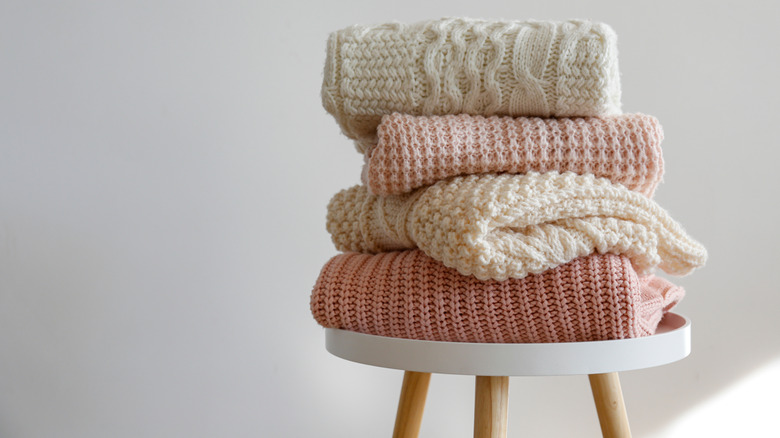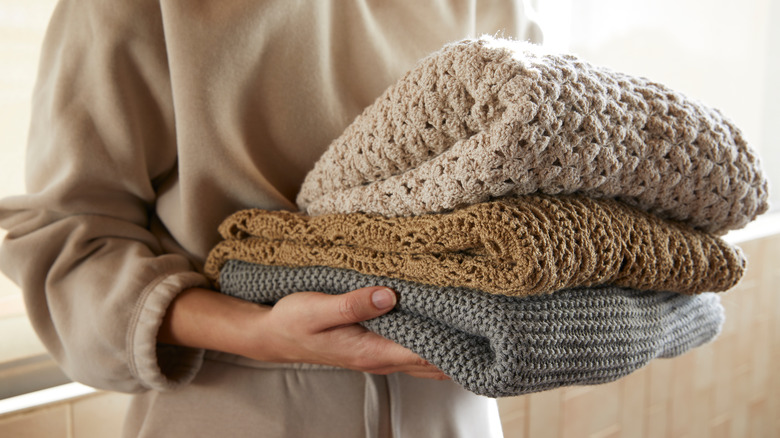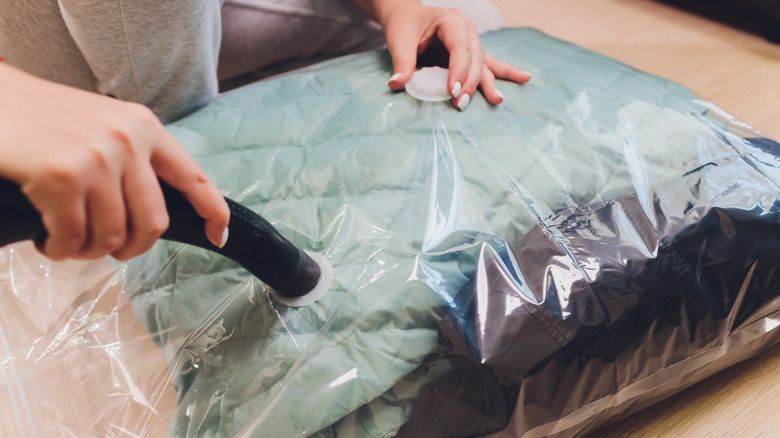An Expert Tells Us How To Properly Fold And Store Winter Clothes For The Summer
Unless you have an extra large closet, there's a good chance you can't keep all of your clothes for every season in one place. Once the weather changes, many people swap out their clothes to reflect the changes in temperature. Voyêtre suggests swapping out your wardrobe at least twice per year: once before the fall and winter and once before spring and summer. To make the swaps easier, take the time to classify your clothes by the season and decide which items you're going to keep for the upcoming year.
The swap, however, might be the easy part. The question is how do you store your out-of-season clothes until they're ready to be worn again? Winter clothes are notoriously hard to store due to their bulky nature. But Kirsten Fisher, certified professional organizer and founder of Imagine Home Organization has some solutions to make storage much easier. In an exclusive interview with House Digest, Fisher explains the best method of folding and storing your winter clothes over the summer months.
Fold each item properly to avoid wrinkles
No one wants to pull clothes out of storage to find them all wrinkly and unwearable. This just creates more work and extra laundry. But putting in the effort to prevent wrinkles before putting your clothes into storage will save you time in the future.
"When folding clothes to store for the winter, be sure to fold on a flat surface and remove wrinkles from the garment," suggests Fisher. "I fold shirts and sweaters into thirds vertically while carefully tucking sleeves so they don't develop wrinkles. I then fold into half and half again for thin items or into thirds for bulky items. For pants, I fold in half vertically and then in half and half again or in thirds." Taking the time to smooth out wrinkles is a crucial step. Without it, you're pretty much guaranteeing a wrinkly garment when you pull it out the next year.
Use totes and lesser-used closets
Once you have all the clothes neatly folded, it's time to consider where you'll keep the clothes until you're ready to use them again. "I store the garments in a weathertight tote to keep humidity out of the garments," Fishes says. Excess moisture and humidity can be bad news for clothes, especially if they'll be sitting for a few months. Natural materials like cotton, canvas, linen, and leather can degrade in excess moisture, explains Molekule. With anything more than 50% relative humidity, you risk mold and mildew growth among the fibers. Above 90% can lead to damage, discoloration, or rot. It's recommended to keep clothes between 30% and 50% humidity to preserve them.
Keep humidity in mind when you're placing your bins to store. "I put the bins up and out of the way," Fisher says. "If I have hanging winter items that need to be swapped out of my closet, I will move them to another lesser-used closet."
Consider space-saving bags
Not everyone has the extra space to store off-season clothing. "If space is particularly tight, you can use the space saver bags that remove the air from the clothing," Fisher suggests. With these, you'll be able to store the same amount of clothing but in far less space. "Then I still put those in totes as they are otherwise difficult to stack and store because they become an odd shape," explains Fisher. If you have multiple bins, be sure to place the heavier ones on the bottom to prevent cracking or warping the plastic.
But Fisher warns, "If you do this, prepare for it to take a bit of time for clothing to return to their original shape and may require laundry or dry cleaning." You should also be cautious about what materials you place in the vacuum bag. Delicate materials like cashmere and silk can be damaged by the compression and leather can crack under the tension, according to Hayden Hill, in which case, delicate items may be better stored in the traditional way.



